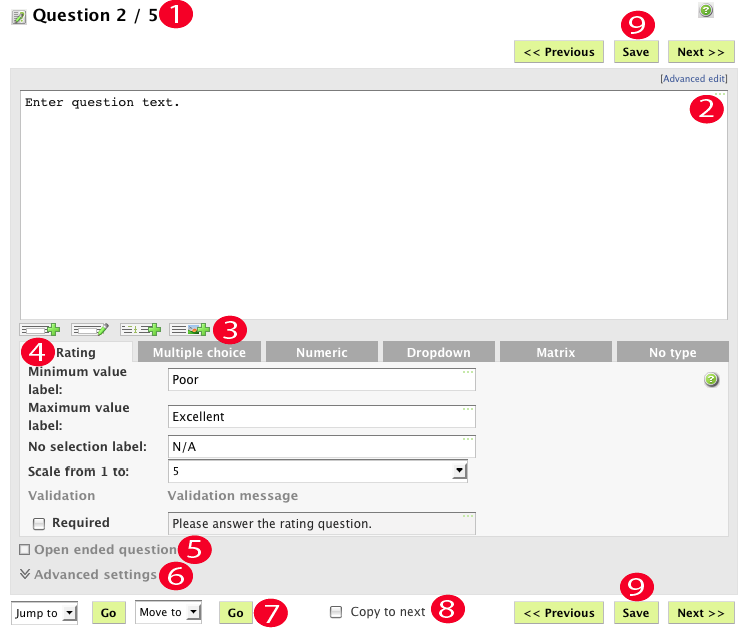Working with Questions
Question Types
There are six different question types in the Survey tool.
- Rating
- Multiple Choice
- Numeric
- Dropdown
- Matrix
- No Type
Rating
A Rating Question is a question type uses a scale to answer the rate of something. For example, the level of performance (poor to excellent).
The question will look like this in the final survey:
Multiple Choice
A Multiple Choice Question allows the person who is taking the survey to choose one or more set answers (that the survey maker chooses).
The question will look like this in the final survey:
Numeric
A Numeric Question is a question where the an answer is an inputed number. example: I am ___ years old.
The question will look like this in the final survey:
Dropdown
A Dropdown Question provides a list of dropdown options to choose from as an answer.
The question will look like this in your survey:
Matrix
A Matrix Question provides a matrix for question sets. Choose the dimensions for your matrix and the row and column labels.
The question will look like this in the final survey:
No Type
A No Type question is a page where survey takers cannot respond unless the "Open ended question" option is checked off. This type of question is for survey takers to make any last comments. The image below is with the "open ended question" box checked.
The question will look like this in the final survey:
Adding Questions
The Question form
- Question Counter. This shows the individual question number over the total number of questions in the poll (e.g., 1/4 means the first question out of four has been completed.
- Question Input Field. Type the question in this field.
- Element Options. Choose to add/edit in-text elements, piping, or images included with the question.
- Insert In-text Element at cursor - In-text elements are uniquely named text input fields. Select to insert an input field at the cursor location. Complete the form that opens with this selection.
- Edit In-text Element - Select to edit an input field. Enter the changes on the form that opens with this selection.
- New Piping - Piping is the ability to dynamically insert/replace text while the respondent is answering the question. Piping replaces text within a question with a respondents answer from a previous question. For example if a question asks "What is your favorite color?", and the respondent chooses 'Green', the next question might ask "Why is 'Green' your favorite color?"
Refer to the Opinio Online Help for additional information. The following Piping types are available:
- Question Response - Inserts a response from a previous question.
- Invitee Data - Use this piping type to capture the name, email, ID, or custom attribute of a person who is invited to participate in a survey via the Invitations module.
- Fixed Value - Inserts a fixed value such as a company name, logo, product name, etc.
- Survey URL Parameter - Refer to Opinio documentation.
- Insert Image at cursor - Images can be any graphical artwork that is saved in an image file format such as a .jpg, .bmp, .gif, or most other graphical file formats. Select to insert a graphic image at the cursor location in the Question Input field.
- Answer Type Selection Bar. Choose from Rating, Multiple Choice, Numeric, Dropdown, Matrix, and No Type. Upon selection, enter the answer parameters in the fields that open.
- Open-Ended Question. Check this option if you want the respondent to enter a response. When selected, parameter fields open where the size of the input field is configured. Adjust the default settings as needed.
- Advanced Settings. Click to configure three advanced layout settings.
- Answer Rotation. Check this option if you want the answers in a multiple choice question and dropdown lists be displayed in a random order. Turning this option on will enable randomizations for all lists (drop-down, multiple choice, matrices) in the current question.
- Custom Question ID. Used to set a custom question ID for easy identification of the question. All custom IDs are stored in the OPS_QuestionAttribute database table and are included in the XML export.
- Question Layout. Determines where your question text should be placed relative to the input fields, lists etc. You can select show text above input fields or show text to left of input fields.
- Jump To and Move To Navigation
- Select Jump To to store the current question and open the question selected on the drop-down list.
- Select Move To to store the current question and move it to any selected position in the survey, allowing you to quickly change the question order.
- Copy To Next option. Check to copy the current question's setup to the next or previous question in the poll. Use this option to quickly generate a copy of a question for faster editing.
- Previous, Save, Next buttons.
- Previous - Click to scroll back to previously saved questions in the poll.
- Save - Click to save the current question setup. A preview opens for checking the results. See below.
- Next - When a question is saved in the poll, click Next to scroll forward to the next saved question.
Editing Questions
Directions to Edit Survey Questions
- Click the 'Questions' link.
- Click 'Edit' on the question you want to edit.
- Edit the question
- (Optional) Continue editing other questions you want to change by clicking next
- Click 'Save' to save the changes you have made to your questions















